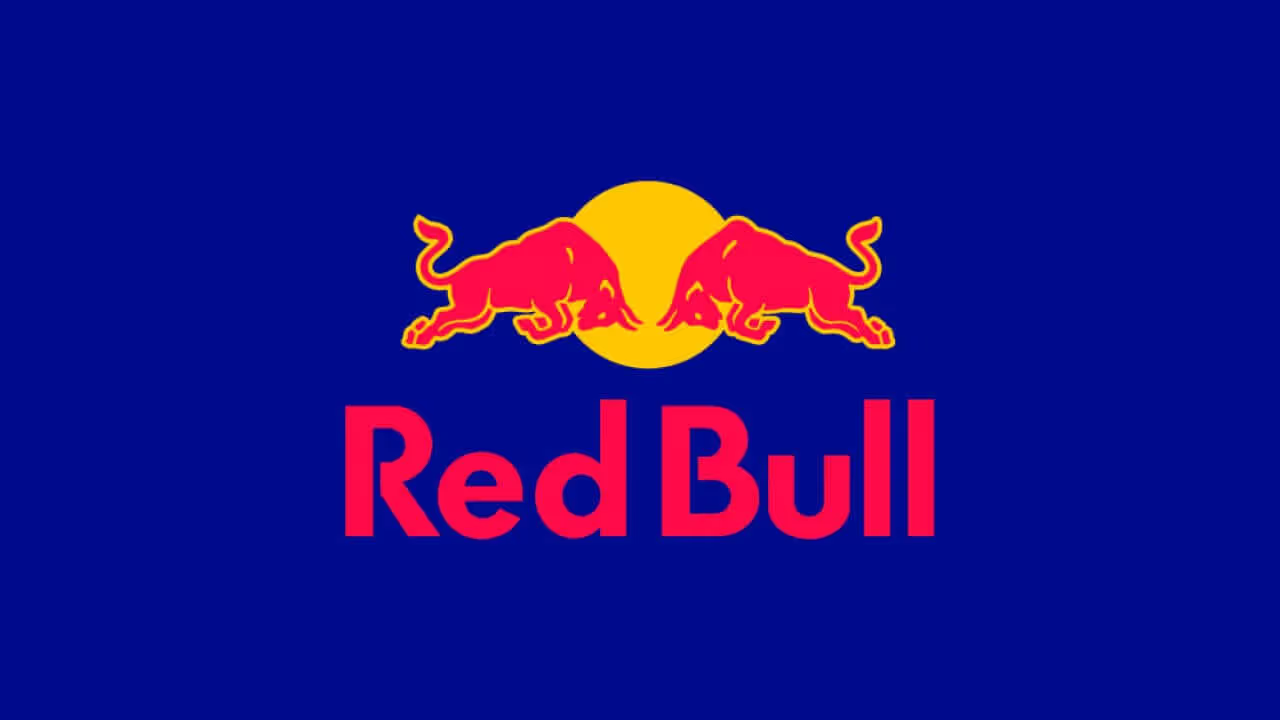Red Bull has grown from a simple energy drink manufacturer to one of the most recognized brands in the world. It has become synonymous with sports, extreme performance, and victory. Red Bull is the extreme athlete of marketing, literally and figuratively.
A few key statistics and facts about Red Bull:
- Number of Red Bull cans sold worldwide in 2023: 12.138 billion
- Revenue of €10.55 billion in 2023
- Red Bull's marketing budget for 2023 is estimated to be €3 billion (it is rumored to be around 25-30% of the yearly revenue)
- Red Bull sponsors athletes in 73 countries around the world.
- Number of employees in 2023: 17,848
- The logo is a breed of cattle called gaur.
Red Bull History
Styrian success-makers
The reasons for Mateschitz's conservatism lie in his family background. He grew up in modest circumstances in the upper Murgtal in Styria. His outstanding success is not an isolated case in this province. Arnold Schwar is a compatriot, as is the tennis player Thomas Muster, who for a time topped the world rankings ahead of Boris Becker, André Agassi, and Pete Sampras.
He is also a compatriot of Frank Stronach, who emigrated to Canada as a worker and returned to his homeland as a co-owner of the global auto parts manufacturer Magna. Styrians are said to have always been a bit their boss. Stubborn but not rebellious, strong, and persevering. Dietrich Mateschitz, who has been friends with half of Austria since his success and is nicknamed "Didi," has needed perseverance for his story to become a real success.
From jetlag to energy drinks
In 1976, Chaleo Yoovidhya introduced his Krating Daeng drink in Thailand. The name means "red gaur" in English. The maker was inspired by the energy drink Lipovitan, in which the main ingredient is taurine, and was popular with Thai truck drivers and blue-collar manual laborers.
When he visited Thailand in 1982, the Austrian-born Dietrich Mateschitz discovered that by consuming Krating Daeng, he was able to overcome the effects of jet lag, caused by the rapid change of time zones, much more quickly during the trip. Since the energy drink phenomenon was still unknown on the Old Continent, he was astonished at how many people consume the product, and almost immediately approached the owners of the company with the idea of bringing it there.
Mateschitz had been the international marketing manager for Blendax (now part of the Procter & Gamble Group) toothpaste at the time. The Yoovidhya family, which had already become rich through the pharmaceutical industry, welcomed the idea and began to develop a European business policy and strategy with the Austrian marketing expert.
Mateschitz founded Red Bull GmbH with Yoovidhya in 1984 intending to develop it into a global brand. Both parties invested $500,000, however, Yoovidhya and Mateschitz owned only 49-49% of the shares in the new company. The remaining 2 percent of the shares went to Yoovidhya's son Chalerm, but the agreement left Mateschitz as the de facto head of the company.
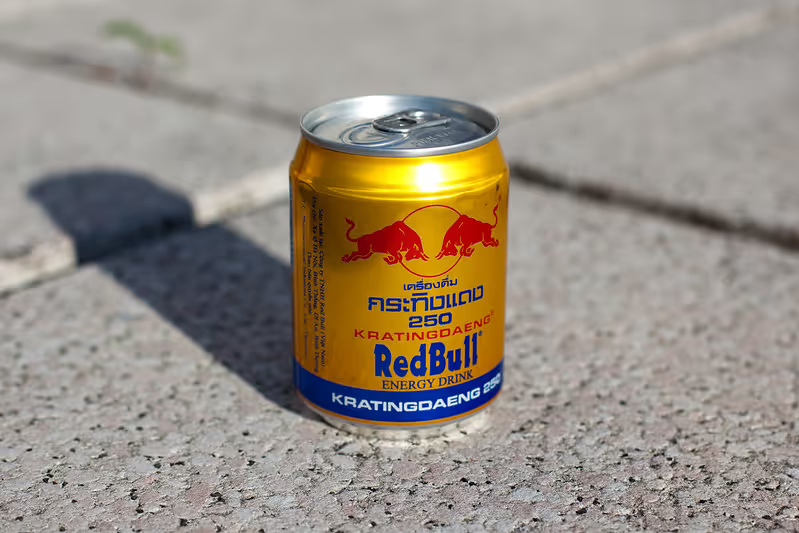
Product launch in Austria
The product was first launched in Austria in 1987. Mateschitz, still a bachelor at 39, has quit his lucrative multinational job and has been trying to introduce the Asian recipe to Austria for two or three years. The new product, the unusual flavors, the colors, the advertising are not the resounding success he had hoped for. After the initial setbacks, Dietrich Mateschitz does what he has never done before - he takes out a loan. The reason for his reluctance is simple: he was raised at home to believe that "a decent person does not have debts," and like many entrepreneurs, he still does not like financial institutions.
The startup’s growth has almost immediately slowed down because several well-known Austrian beverage companies considered the revolutionary idea too risky and refused to partner with Red Bull. The food authority was also not a fan of Red Bull, considered it dangerous, and banned its marketing in many places - but Mateschitz was not discouraged. Dietrich Mateschitz cites the three most difficult years of his life as the early days of Red Bull.
Being an experienced manager, he refused to lower the price of the not exactly cheap beverage. He is vigilant about consumer behavior. The highly stimulating product was finally a hit in Austrian discotheques. It was tempting to dance the night away. Word of the new wonder “drug” spread quickly across the border. However, on the German side, Red Bull was still not allowed to be marketed. It was banned for a time in Hungary, France, and Denmark because of what they consider to be its high caffeine and taurine content. It is the desire for the forbidden fruit that has brought the real breakthrough. Consumers "smuggle" a bootleg number of Red Bulls across the then non-EU Salzburg border crossing into Bavaria, where it is sold in nightclubs in violation of the law. From then on, the triumphal procession is unstoppable. And during this time, the custom of mixing it with vodka also arises.
Germany and the United Kingdom were introduced to Red Bull in 1994 after the company’s expansion in Eastern and Central Europe. It was able to win a 75 percent market share on the American energy drinks market despite the slow start and late expansion to the US in 1997.
In the process, Red Bull has also garnered some criticism for its use of extreme sports marketing and its impact on health. Due to this, the European Food Safety Authority (EFSA) and other food regulatory agencies have limited the levels of caffeine, taurine, and glucuronolactone in Red Bull and other energy drinks.
Key takeaways:
A serendipitous meeting between the Austrian and Thai founders of Red Bull was quickly followed by the realization of an excellent business opportunity and action. The recipe was ready - even if it still needed to be refined for European tastes - and the parties focused on market development strategies, sales, and marketing activities.
Still, launching the product in Austria was not a success, and many founders would have given up at this point. But Mateschitz kept his eyes open and recognized what the sales drivers would be in the early days.
- Word-of-mouth marketing,
- The feeling of uniqueness (energy drinks were not yet known to the European public),
- A stronger effect than coffee, which, mixed with alcohol, stimulated parties in Eastern Europe as a non-addictive and non-consciousness-altering substance,
- The progressive association of the brand with sports, in addition to nightlife.
Together, these elements have served to build Red Bull's success on an increasingly efficient and planned business foundation.
The Products
The product portfolio of the company
Three of Red Bull's products are core products that are sold in all relevant markets, regardless of culture or target group:
- Red Bull energy drink: the familiar gray-blue metal can that comes in a 250 ml edition. In some countries, it is also available in a 350 ml and a 500 ml version.
- Sugar-free Red Bull: Instead of sugar from sugar beets, the company uses aspartame, sucralose, and acesulfame K to sweeten the product. The product's other ingredients and packaging are the same as the original energy drink.
- Red Bull Zero Sugar. The Zero and sugar-free variants differ little in terms of content. According to the company, the only difference is the taste.
However, since 2013 the brand launched the first Red Bull Editions to expand its flavor offerings—and they have been launching new editions consistently. There have also been numerous drinks that have been launched in limited quantities or connected with specific sporting events. These include The Tropical Edition, The Coconut Edition, The Red Edition, and The Summer Edition, which became a permanent edition in Red Bull's portfolio with its latest launch being the juneberry flavor. And, in April 2024, the brand launched its first ever fully sugar-free Pink edition—adding a permanent sugar-free flavor to their portfolio. Combined, Red Bull’s Editions made up 8% of the brand’s total sales in 2023.
However, Red Bull not only limits the time of availability but also sells specific, localized products for the largest markets. For example, ORGANICS by Red Bull, which is only available in German, is not an energy drink but a soft drink that comes in six flavors. These include cola, tonic, and ginger drinks.
Red Bull cans are 100% recyclable, and the company has optimized its production process through "wall-to-wall production," which significantly reduces the transport distances of cans between manufacturing and filling locations in key facilities in Austria, Switzerland, and the United States.
Product localization
Almost all of the markets in APAC are served by Red Bull, and the company uses local development strategies to cater to consumer tastes in each market. Red Bull markets in the APAC region curate their product portfolios, and it takes a lot of time for each market to develop the most appropriate product selections. Local and center teams are continuously reviewing the portfolio of products to ensure that the energy, taste, and size requirements are met. Though the original blue and silver Red Bull Energy Drink is still a popular beverage, Red Bull is also interested in creating new products to match the changing tastes of the market.
Red Bull Editions are a seasonal range of localized products. To give an example, Red Bull has a Coconut edition in Singapore that includes coconut and blueberry flavors; in Australia, there are Orange editions (orange flavors), Tropical editions (tropical fruit flavors), and Red editions (watermelon flavors).
Each Red Bull market has a local team that interprets the meaning of the products to ensure they are relevant to the target customers. There is room for growth in the energy drink market through premiumization, even though the market is well established.
Manufacturing
A new Red Bull production facility was being built in Glendale, Arizona. A joint venture between Red Bull, Rauch Fruit Juices, and Ball Corporation, RRB Beverage Operating, invested USD 250 million to build a new 700,000 sq ft-sized facility. Initially planned to begin production in 2021, the facility is now operational and employs around 140 people as expected. While COVID-19 presented some challenges, the project moved forward successfully, underscoring Red Bull's commitment to expanding its U.S. operations.
Instead of keeping the production process in-house, RB outsourced it to Rauch. Among other beverages, it produces Red Bull's drinks in Nüziders, Austria, and Wildenau, Switzerland. It is only 40 kilometers between the two production facilities despite being in different countries.
It was previously made at a Swiss plant and imported to the U.S., but the company's growing popularity in North America and a threat to taxing cans and products imported from Europe, in general, led to the investment.
One of the joint venture partners, the Ball Corporation, which specializes in the production of aluminum and steel packaging for the food and beverage industry, opened an aluminum can manufacturing plant in Goodyear, Arizona in 2019, not far from the new project site in Glendale.
Sales channels
As a manufacturer of soft drinks, Red Bull does not market its products itself but distributes them to restaurants and stores via Red Bull-owned distribution companies. One such company is Red Bull Distribution Company, which is responsible for distribution in North America. The Group currently employs around 6,000 sales staff who distribute its products in 170 countries around the world.
The sales employees directly involved in the sales process are usually field sales representatives. They cover a predetermined territory by driving around and replenishing products from Red Bull in restaurants and convenience stores. They are also responsible for ensuring that the energy drinks are in the right, highly visible places on the shelves and that the company logos get the attention they deserve.
Of course, the larger chains and online beverage stores are already negotiating directly with distributors. The company's sales activities are rounded off by various corporate purchases.
Key takeaways:
Beverage retailers in particular tend to offer their customers a diversified product portfolio to generate more sales so that they can not only order a specific beverage but also upsell it. This involves offering additional options (both products and services) to a customer who has already been won over, which can then be sold at a much higher profit because there is no need to advertise and approach the customer again. In contrast, Red Bull has opted for a narrow product range - for a long time, there was only one type of energy drink and one flavor. Today, that range has broadened, but there are still many subsectors (e.g., alcohols, premium products) where there is room for further expansion.
Red Bull works with several international and local distributors, typically owned by RB. Sales are always B2B, with restaurants, small and large grocery stores, and corporate customers on the other side.
The Red Bull Brand
The Red bull brand stands out as a category dominating queen holding 43% of the global energy drink market in Dec 2022. Second comes Monster with a 35% market share.
Company culture
The vision statement of Red Bull is “(The company) is dedicated to upholding Red Bull standards while maintaining the leadership position in the energy drinks category when delivering superior customer service in a highly efficient and profitable manner. We create a culture where employees share best practices, dedicated to coaching and developing our organization as an employer of choice.” (Source: redbull.com)
According to reviews on Indeed and Comparably, Red Bull is successful not only in building an outward-facing brand but also in creating a high-quality corporate culture. Typical feedback praises the internal social life, work environment, and highlights internal development opportunities. However, as in any other organization, those who work under a poorly performing manager are understandably dissatisfied with management skills, work-life balance, and supervisor availability.
Can of innovation: a branding move
The can became the symbol for Red Bull, even though it has been commonly used among beverage manufacturers. There is, however, a significant difference: instead of the usual 330 ml can, which is a bit chunkier, Red Bull has introduced the 250 ml sized container, which is thinner and taller than usual. There are two reasons for this: the unique appearance makes the product stand out from the competition, and it explains why Red Bull is much more expensive than the usual packaged drinks.
Red Bull’s target market: for those who need energy
Red Bull’s target market is young people between the age of 15 and 45 with high income. The company segments its target market even further offering as the main benefit a sense of belonging and enhanced physical and mental performance.
Matschitz explained the failure of Red Bull's first consumer test by claiming that such products only succeed in their intended environment. In sterile laboratories, no one needs extra energy, so Red Bull could not be treated at its true value. The moment the drink was introduced into gyms, parties, and bars, or even boardrooms, the rejection stopped, because the product found its right target audience.
Red Bull’s logo and design over the years
The energy drink was originally created for Muay Thai fighters and blue-collar workers in Thailand. A logo where two red bulls were readying to fight and the bright yellow sun rising behind them is typical for the APAC region. The only direct change was the “Red Bull” inscription written in bold, English font.
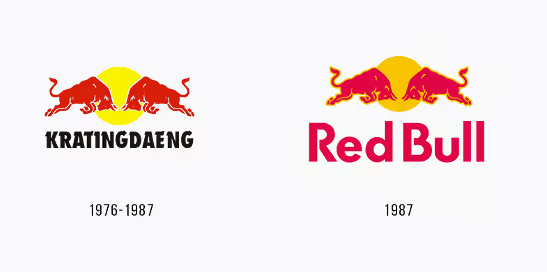
The Red Bull logo did not change significantly over the years. What makes the story special is that Mateschitz's marketing background allowed the team to spend extra time finding the right design. However, both the logo and the name and colors scored poorly on focus-group questionnaires. Nevertheless, the owners stuck to their original vision and did not change the design "rescued" from Thailand. Time has proven them right.
Red Bull brands and subsidiaries
Red Bull operates under several brands and subsidiaries that extend its influence beyond just energy drinks.
Red Bull Racing
AKA Red Bull AKA RBR AKA Oracle Red Bull Racing is a Formula 1 racing team. The team won the 2021 championship with its driver Max Verstappen.
Scuderia AlphaTauri
AKA AlphaTauri is the second Formula One racing team of Red Bull. Originally the company’s junior team, today its considered to be the sister team of Oracle Red Bull Racing.
New York Red Bulls & New York Red Bulls II
The company’s two American professional soccer teams. The first participates in the Major league and the second in the second tier league.
FC Red Bull Salzburg
AKA FC Salzburg, the company’s Austrian professional football club. Red Bull bought the club in 2015 and changed its colors, a move that its fans found controversial.
FC Liefering
Red Bull's second league Austrian football club.
RB Leipzig
The German professional football club nicknamed Die Roten Bullen. The company bought the team in 2009 and in less than 9 years took it from the fifth tier league to the top-flight Bundesliga.
Red Bull Brasil & Red Bull Bragantino
The two Brazilian football clubs whose teams compete in the second and top tier of São Paulo state football league respectively.
EHC München & EC Red Bull Salzburg
Red bull’s ice hockey teams. The first competes at the highest level of professional German ice hockey. And the second competes in Austria’s top-tier ice hockey league.
Red Bull Records
It’s Red Bull’s global record label focusing on more niche genres like rock, alternative rock, punk rock and hip hop with bands like Awolnation, Twin Atlantic, and Beartooth.
Key takeaways:
The example of Mateschitz is rather the exception that proves the rule because his decisions - especially in the early years - were always at odds with business logic and common sense. The launch of the energy drink Red Bull in Europe was prepared through a series of processes: Testing the product, obtaining food safety and market approvals, market research as part of the launch. In the end, there were almost no areas left to support the owners' ideas, as neither the food authority nor market research considered energy drinks to be a good product.
Mateschitz, however, stubbornly stuck to his original ideas and, adapting some of the intellectual property brought from Thailand to European tastes, practically single-handedly created a youthful, trendy and energetic brand Red Bull.
Red Bull Marketing Strategy - Sponsoring Sports, Athletes And Events
Red Bull global marketing strategy focuses, but it’s not limited to, sponsorships of extreme sports, athletes and events of every scale, from local to global.
The company generates massive awareness with its presence in unique first-ever events like Felix Baumgartner parachute jump and in major regular events like the Volcom Pipe Pro and the Freeride world tour.
Red Bull’s marketing strategy, however, includes more traditional marketing practices and channels like TV commercials and social media with millions of followers across its Facebook, Instagram, Twitter, LinkedIn, and Youtube tens of accounts. It runs ads across every channel, trying to appear in front of its target audience everywhere it goes.
Red Bull marketing budget
A question on a lot of people's minds is how much does red bull spend on marketing? Unfortunately, Red Bull does not share its marketing budget, but it is rumored to be around 25% of the yearly revenue. So whilst we can only guesstimate what it spends, one thing we know is that it's a lot of money and a very important focus for Red Bull.
When the product becomes the means of Red Bull advertising
Sponsored stars are today's flesh-and-blood heroes: athletes, drivers, Formula 1 racers, and extreme athletes who stand for real achievement.
In addition to financial support, the stars receive equipment, clothing, and accessories with the Red Bull logo. And of course their advertised product, energy drinks in the required quantity. Red Bull's branded merchandise is particularly valuable because, unlike many beverage competitors, the company does not mass-produce merchandise - it is available only in the inner circle.
The international marketing activities of Red Bull are aimed primarily at young people who are attracted to and like extreme sports. The range of extreme sports targeted is very broad and includes:
- Mountain biking
- Motocross
- Surfing
- Snowboarding
- Skateboarding
- Kayaking
- Wakeboarding
- Cliff jumping
- Ice skating
- Freestyle motocross
- Rallying
- Formula 1
- Break dancing.
Red Bull also uses music and video games for marketing purposes and has brought in celebrities like Eminem (through its support of the Red Bull "EmSee Battle Rap championships").
Red Bull is also known for its events, including music and art conventions. In Hungary, the company launched Red Bull Pilvaker in 2012, one of the country's most unique music and cultural projects, which commemorated the 1848 Revolution and the War of Independence with the help of outstanding contemporary art artists. The popularity of Red Bull Pilvaker is reflected in the fact that in recent years all tickets for performances at Erkel Theater, which seats almost 2,000 people, were sold out within a few days.
Red Bull also maintains soccer teams in Austria, Germany, the United States, and Brazil - these teams also carry the brand name, Red Bull. By associating the energy drink with these activities, the company aims to reinforce the "cool" image of the product and thus the strength of the brand. The energy drink has also created a market for over 150 additional souvenir items.
On the PlayStation 3 community platform PlayStation Home, Red Bull created a dedicated in-game island in 2009 to specifically promote the energy drink Red Bull and the racing series Red Bull Air Race. In January 2012, Red Bull also opened its first personal community area, the " Red Bull House of Skate," which featured an indoor skating rink for visitors.
Red Bull's sports sponsorship activities focus on supporting talented young athletes and helping them achieve their goals. The Red Bull Junior program in motorsports is the most prominent branch of this, but the company follows this philosophy in its support for athletes, regardless of the sport. Sebastian Vettel, Daniel Ricciardo, and Danyiil Kvjat are among the most prominent students of the Red Bull Junior program.
Formula One Red Bull Racing
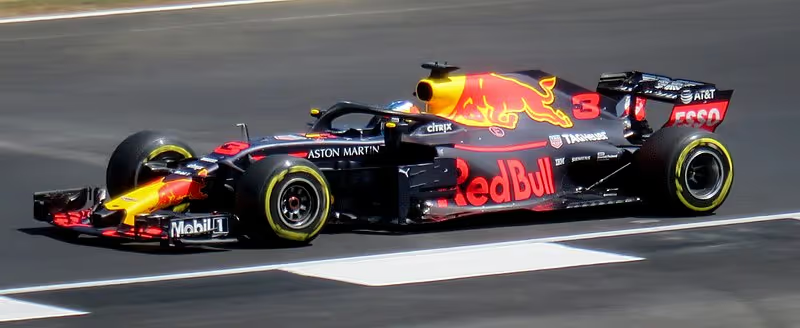
Red Bull Racing is the Austrian Formula 1 team owned by the energy drink company Red Bull. The company's other team is Scuderia Toro Rosso (later Scuderia AlphaTauri).
The team's direct predecessor is the Stewart Grand Prix, founded in 1997 by Jackie Stewart. In late 1999, it was sold to the Ford Motor Company, which raced it under the name Jaguar Racing. In 2004, Ford decided to sell the unsuccessful but costly team. It was bought by Dietrich Mateschitz, owner of the energy drink company Red Bull. The team was then able to take to the grid at the 2005 Australian Grand Prix as the successor to Jaguar, now in the blue and silver colors of Red Bull energy drinks.
Red Bull was no stranger to motorsport's premier class, having previously sponsored Sauber, Arrows, and its predecessor Jaguar. Having started its own team, Red Bull naturally terminated its contract with Sauber (the Arrows had already ceased to exist in 2002). The drinks company has also appeared in the Formula 3000 series and its successor, GP2, and has a European talent scouting program called Red Bull Junior Team. Later Formula 1 drivers have also emerged from the program, with Enrique Bernoldi, Christian Klien, Patrick Friesacher, Vitantonio Liuzzi, and Scott Speed all having raced in the premier class.
RBR enjoyed immediate success in its first season in 2005, thanks to two of its drivers, Coulthard and Klien. The 2005 Red Bull RB1 was based on the already papered Jaguar R6. The team used the weakest Cosworth engines and Michelin tyres throughout the season. The team exceeded expectations to finish seventh among constructors with 34 points.
For the 2006 season, Red Bull Racing changed engine suppliers and used Ferrari V8 power units for the season. Adrian Newey, who was signed from McLaren in November 2005, was appointed as chief designer. Newey did not play a major role in the design of the RB2, which was almost complete by then, and instead started work on the 2007 model. By 2007, the Adrian Newey-designed RB3 was finally completed, with the Renault engine replacing Ferrari's. Mid-season saw the arrival of Geoff Willis, who had worked as technical director at Williams and BAR and then at Honda. Following the departure of Michelin, Red Bull Racing naturally started on Bridgestone tyres. On the racing front, David Coulthard remained with the team, while Mark Webber took the other seat. Webber left the predecessor Jaguar after 2004 and joined the energy drinkers after two disappointing seasons at Williams. The team finished 5th in the constructors' championship with McLaren eliminated and 24 points, David Coulthard 10th with 14 points, and Mark Webber 12th with 10 points.
For 2009, the retiring David Coulthard was replaced by Sebastian Vettel from Toro Rosso, while Mark Webber remained with the team. The team ended the year with a double victory at the Abu Dhabi Grand Prix. Vettel finished second in the individual championship with 84 points, 11 behind world champion Button. The team finished second in the constructors' championship, 18.5 points behind Brawn GP. From 2010-13, RBR enjoyed a truly golden era, its World Championship victories making it unchallenged.
The 2014-20 Formula 1 era brought less success for Red Bull (regularly replaced by Mercedes in first place), but remained a worthy rival to Ferrari. In the 2021 season, with a Honda engine, they continue to pile on the surprises, and their fans are predicting the resurrection of RBR in an ever-strengthening F1 team.
In the 2023 Formula 1 season, Max Verstappen and Red Bull Racing shattered multiple records, dominating both the drivers' and constructors' championships. Verstappen secured 19 wins out of 22 races, including an unprecedented 10 consecutive victories. Red Bull achieved 21 wins in total, missing out only at the Singapore Grand Prix, resulting in an astounding 95.4% win rate for the team. Verstappen also set a new record for the most points in a season with 575 and led over 1,000 laps throughout the year, further solidifying his and the team's extraordinary performance.
Red Bull Ring
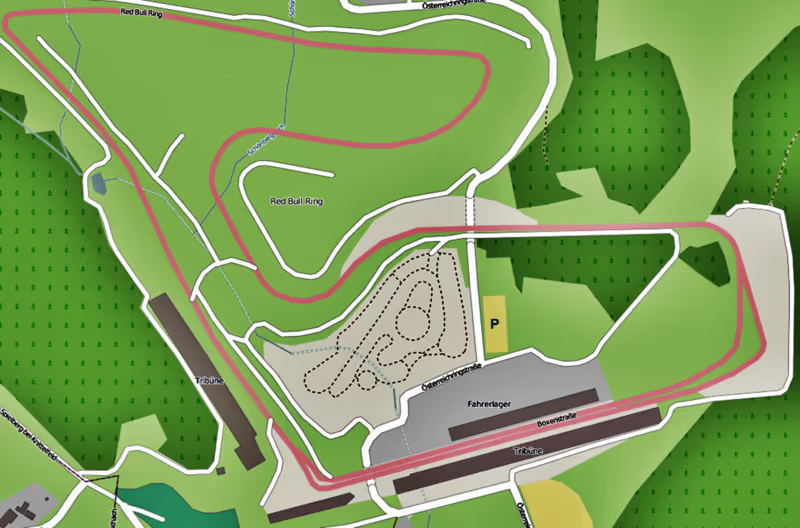
The Red Bull Ring (originally called Österreichring, between 1997 and 2003 A1-Ring) is an Austrian race track in Styria. The circuit itself is located in the territory of the municipality of Spielberg, but its access roads are in the immediate vicinity of the municipality of Zeltweg, which is why it is often referred to as the "Zeltweg circuit". The track was renovated in 2011 with financial support from the energy drink manufacturer Red Bull to make it suitable for Formula 1 again and will be back on the calendar for the 2014 season.
Red Bull Racing has won at its home track four times since its inception.
Red Bull sponsoring other sports
- In 2006, Red Bull announced they would sponsor the NASCAR Team Red Bull. Lowe's Motor Speedway was their first stop in the Nextel Cup Series. The team was shut down in December 2011 and its assets were acquired by BK Racing.
- A major sponsor of Repsol Honda, Red Bull is the title sponsor of Red Bull KTM Factory Racing and Red Bull Honda World Superbike Team.
- Football has also been a huge part of the company's activities. The Austrian club SV Austria Salzburg was purchased by Red Bull on 6 April 2005, and it was renamed Red Bull Salzburg, a move that has been heavily criticized by supporters' groups in Austria and across Europe. FC Liefering has also been purchased as Salzburg's feeder club.
- Since 2000, the company has owned the Salzburg team in the Austrian Hockey League, now named Red Bull Salzburg. Throughout 2012 and 2013, Red Bull became the team's title sponsor and then bought the club outright.
- A new League of Legends team was formed by Red Bull in 2017, Red Bulls, which competed in the European League of Legends Challenger Series from 2017 until it folded in 2018. Several Red Bull sponsored fighting game players to compete in Tekken and Street Fighter games, as well as The International winner OG, who competes in Dota 2.
- Red Bull also sponsors a wide range of extreme sports events, including the Cliff Diving World Series, BC One breakdancing competition, Art of Motion parkour event, Crashed Ice ice cross racing, and the Romaniacs Hard Enduro Rallye, showcasing their dedication to high-energy, thrilling sports that resonate with adventure-seeking fans.
Felix Baumgartner parachute jump from space
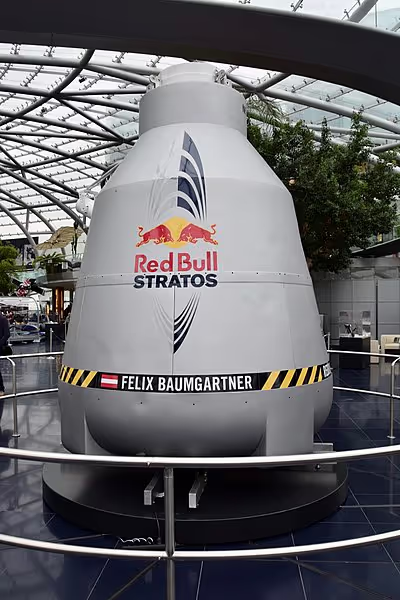
Baumgartner and his team saw a mission in the world record attempt, for which the athlete had been preparing since 2005. The jump offered the opportunity to collect data to improve life-saving for astronauts and pilots or potential space tourists and to study the behavior of the human body in the stratosphere. It is critical to make the return from space safe for space crews, as they may have to eject from the aircraft and it is life-threatening to enter the stratosphere in an unprepared space suit in such an emergency.
The first record attempt was scheduled for Oct. 9, 2012, at 11:42 a.m. local time, but a strong wind prevented the 834,497-cubic-meter balloon from inflating safely, as it was twisted by the wind. Wind gusts of up to 40 km/h were measured at the top of the balloon, although the wind speed was not supposed to exceed 5 km/h.
The next attempt was therefore postponed until Sunday, October 14 - a postponement that tested everyone's patience but was the only way to ensure safety. At the press conference after the jump, FAI record holder Brian Utleya announced that Baumgartner had reached a speed of 1342.8 kilometers per hour (Mach 1.24), breaking the speed of sound. The pilot came down from a height of 39,045 meters in 4 minutes and 20 seconds, covering 36,529 meters in freefall.
Key takeaways:
Red Bull, like Ferrari, has found in sports the marketing platform that best reaches its audience. However, the company has not limited its sponsorship activities to motorsports but supports all sports from ice hockey to extreme sports. The company invests most of its marketing budget in financing the Red Bull Racing Formula 1 team and maintaining the racetrack at the Red Bull Ring.
Red Bull also supports music as a nightlife player and various events aimed at partygoers.
Final thoughts and key takeaways of Red Bull’s story
Who owns Red Bull today?
Red Bull GmbH is a private company with its headquarters in Salzburg, Austria. Two billionaires own Red bull:
- Thai businessman Chalerm Yoovidhya, who owns the majority of the company sitting at 51%. His net worth as of 2021 is estimated at $24.5 billion.
- Austrian businessman Dietrich Mateschitz, who owns 49% of the rest of the company. His net worth as of 2022 is estimated at $26 billion.
Growth by numbers
According to Forbes, the brand that gives you wings sold more than 12 billion cans in 2023 alone. Among the fastest-growing markets were India (+30%), Brazil (+22%), and Eastern Europe (+22%). Using a marketing strategy built around extreme events, Red Bull has sold more than 100 billion cans worldwide sinсe its launch in 1987.
And there's no signs of stopping—the revenue of energy and sports drinks sold worldwide amounted to approximately 193 billion U.S. dollars in 2023 and is estimated to increase to just over 240 billion U.S. dollars by 2027.
Key takeaways from Red Bull's story:
- The founders’ agility: Red Bull would certainly not look the way it does today if the founders - a Thai pharmaceutical entrepreneur and an Austrian marketing manager - had not had a clear vision for the brand right from the start.
- Product portfolio: The soft drinks market is characterized by the dominance of aggregators (e.g. Coca Cola, which contrary to popular belief does not only produce Coke). To counter this trend, Red Bull has from the beginning thought in terms of a small product portfolio and focused on the energy drink market rather than a diversified range. It was not an easy task, as it was a pioneer in the field at the time of its launch - no other energy drink existed in Europe. The company invested a lot of energy in educating the market, which at first did not welcome this unique product, but now it has become an integral part of it.
- Marketing: Instead of investing millions of dollars in television, radio, and Internet advertising, Red Bull took a different approach from the beginning. Although it was initially forced to do so because many countries did not officially license the energy drink, word of mouth is still the strongest element in the company's marketing. The founders succeeded by identifying the two areas where there was a real need for energy drinks and focusing all marketing activities on them.
- Sponsorship: Red Bull quickly found its audience among athletes as well as party-goers, so it's no wonder that the company turned to sports sponsorships. One of Red Bull's main marketing weapons has been its own Formula 1 team, as well as sponsorship of a number of ball and extreme sports.
The companies more than 30-year history is a powerful story of challenges, of working against the wind, of the founders' strong vision, of defying business logic, and of perseverance. Even though the Austrian entrepreneur Dietrich Mateschitz has made countless decisions that would not have worked for others and that go against everything that business can teach us, the success of his company is beyond question.
If there is anything we can learn from him, it is surely his belief in his team and his own instinct to put an unknown product on the world map. Red Bull now inspires millions of people a year, its sales are skyrocketing (based on the sales statistics, every person on earth could drink one Red Bull), and its marketing efforts are leading the way for many other companies in the industry.


